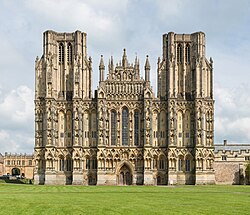
Back كاتدرائية ولز Arabic Уелска катедрала Bulgarian ওয়েলস ক্যাথিড্রাল Bengali/Bangla Iliz-veur Wells Breton Catedral de Wells Catalan Wellská katedrála Czech Kathedrale von Wells German Katedralo de Wells Esperanto Catedral de Wells Spanish Wellseko katedrala Basque
| Wells Cathedral | |
|---|---|
| Cathedral Church of St Andrew | |
 West front of Wells Cathedral | |
 | |
| 51°12′37″N 2°38′37″W / 51.2104°N 2.6437°W | |
| Location | Wells, Somerset |
| Country | England |
| Denomination | Church of England |
| Previous denomination | Roman Catholic |
| Website | wellscathedral |
| History | |
| Dedication | Saint Andrew |
| Consecrated | 23 October 1239 |
| Architecture | |
| Heritage designation | Grade I listed building |
| Designated | 12 November 1953[1] |
| Style | Gothic (Early English, Decorated, and Perpendicular) |
| Years built | 1176 – c. 1490,[1][2] |
| Specifications | |
| Length | 126.5 m (415 ft)[3] |
| Width | 20 m (66 ft)[3] |
| Width across transepts | 47 m (154 ft)[3] |
| Nave height | 20.5 m (67 ft)[3] |
| Number of towers | 3 |
| Tower height | |
| Bells | 10 |
| Administration | |
| Province | Canterbury |
| Diocese | Bath and Wells (since c. 909) |
| Clergy | |
| Bishop(s) | Michael Beasley |
| Dean | Anne Gell (Acting) |
| Precentor | Mary Bide (Acting) |
| Chancellor | Megan Daffern |
| Archdeacon | Anne Gell (Wells) |
| Laity | |
| Organist(s) | Alexander Hamilton (Acting)[4] |

Wells Cathedral is an Anglican cathedral in Wells, Somerset, England, dedicated to St Andrew the Apostle. It is the seat of the Bishop of Bath and Wells, whose cathedra it holds as mother church of the Diocese of Bath and Wells. Built as a Roman Catholic cathedral from around 1175 to replace an earlier church on the site since 705, it became an Anglican cathedral when King Henry VIII split from Rome. It is moderately sized for an English cathedral. Its broad west front and large central tower are dominant features.[5] It has been called "unquestionably one of the most beautiful"[6] and "most poetic" of English cathedrals.[7]
Its Gothic architecture is mostly inspired from Early English style of the late 12th to early 13th centuries, lacking the Romanesque work that survives in many other cathedrals. Building began about 1175 at the east end with the choir. Historian John Harvey sees it as Europe's first truly Gothic structure, breaking the last constraints of Romanesque.[8] The stonework of its pointed arcades and fluted piers bears pronounced mouldings and carved capitals in a foliate, "stiff-leaf" style.[9] Its Early English front with 300 sculpted figures[7] is seen as a "supreme triumph of the combined plastic arts in England".[10] The east end retains much ancient stained glass.[7] Unlike many cathedrals of monastic foundation, Wells has many surviving secular buildings linked to its chapter of secular canons, including the Bishop's Palace and the 15th-century residential Vicars' Close.[5] It is a Grade I listed building.[1][11]
- ^ a b c Historic England. "Cathedral Church of St Andrew, Chapter House and Cloisters (1382901)". National Heritage List for England. Retrieved 5 January 2013.
- ^ "Wells Cathedral – Wells, Somerset". Archived from the original on 10 April 2021. Retrieved 17 June 2022.
- ^ a b c d e f "Dates and Dimensions" (Word). Wells Cathedral. Archived from the original on 3 December 2013.
- ^ "Organists". Wells Cathedral. Retrieved 25 February 2023.
- ^ a b Swaan 1984, pp. 188–196.
- ^ Oggins, Robin. Cathedrals Archived 4 May 2018 at the Wayback Machine, p. 42 (Sterling Publishing Company 1996).
- ^ a b c Clifton-Taylor 1967, p. 274.
- ^ Harvey 1987, p. 19.
- ^ Clifton-Taylor 1967, p. 77.
- ^ Harvey 1961, p. 63.
- ^ Cite error: The named reference
pastscapewas invoked but never defined (see the help page).
© MMXXIII Rich X Search. We shall prevail. All rights reserved. Rich X Search